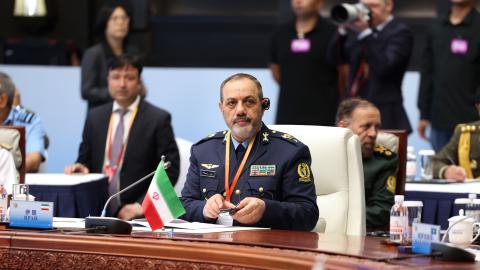It was early morning on Saturday, July 11, 2015 when Cairo awoke to the sound of a huge explosion. Coming just 12 days after the assassination of Prosecutor General Hesham Barakat, and ten days after a massive assault on the city of Sheikh Zuwaid by Wilayat Sinai, the Islamic State’s local affiliate, residents feared the country’s widening terrorist insurgency had claimed another high-ranking official in the heart of mainland Egypt.1 It soon became apparent that the attack had instead targeted the Italian consulate, a rather soft diplomatic target. More significant than the target, however, was the quickly released statement claiming responsibility. Instead of a claim by Wilayat Sinai, the Islamic State mother organization itself took the credit.2
The following month in the early hours of August 20 residents in north Cairo awoke once again to a terrifying explosion. This time the target was a State Security building on the northern-most edge of the Cairo metropolis, and once again Islamic State took responsibility for the attack not Wilayat Sinai.3
This raises significant questions regarding why the Islamic State would directly claim, and presumably conduct this attack and whether something was amiss in the relationship between the Islamic State in Raqqa and its Egyptian affiliate? Reports had after all indicated back in November 2014, when Ansar Bayt al-Maqdis (ABM), or Supporters of Jerusalem, gave its allegiance to self-proclaimed Caliph, Abu Bakr al-Baghdadi, that not all of its members were enthusiastic about becoming the organization’s Wilayat Sinai. Perhaps these fissures had widened and the group would return to the al-Qa`ida umbrella. Or perhaps this meant that a new branch was about to be announced in mainland Egypt by the Islamic State. The Egyptian press had been abuzz in previous months with news of the awaited announcement of Islamic State Wilayat el Sa’eed (Egypt’s southern governorates).4 It was hardly a coincidence that the Islamic State had only granted ABM the title of Wilayat Sinai and not Wilayat Ard el-Kinana (Egypt) indicating the potential for more than one affiliate in Egypt.5
Tracing the growth of Wilayat Sinai from its obscure origins to its emergence as the main jihadi threat to Egypt sheds light on its continued struggle to balance its local environment in Sinai with its aim of transcending Sinai and dominating the Egyptian jihadi scene, all while linking to transnational jihadism in its most radical from: the Islamic State.
Understanding the complex dynamics that first allowed ABM to grow into a national-level actor, the reality of a fragmented and diverse jihadi landscape in the Nile Valley, and the possibility of growing competition in Egypt between the Islamic State and al-Qa`ida helps explain the state of affairs today both inside the Wilayat Sinai and the overall Egyptian jihadi landscape. This article argues that early assumptions about Wilayat Sinai need to be corrected and that by declaring allegiance to the Islamic State, the jihadi group has complicated its ability to maintain and extend its operations in the Nile Valley and “go national.”
Rather than making a “leap” from the Sinai desert by dispatching operatives west of the Suez after the July 2013 coup that ousted the Muslim Brotherhood-led government, the group became involved in “mainland” Egypt by cooperating with Nile Valley-based operatives and groups, who reached out to them as early as 2011. The jihadism of the mainland, even under the banner of ABM, was and still is largely carried out by cells indigenous to the Egyptian heartlands, who are struggling to resurrect the lost jihad of the 1990s.
Origins
From 2004 to 2006, a series of attacks targeting Red Sea tourist resorts in south Sinai left at least 145 people dead. Terrorism was back in Egypt following seven years of relative quiet after the notorious 1997 Luxor massacre and the subsequent renunciation of violence by Egypt’s then leading terrorist group Gama’a Islamiya. The Sinai Peninsula, long isolated from jihadi developments in the mainland, was now at the forefront of the jihadi revival.
Despite being a part of Egypt since the time of the Pharaohs, the Sinai Peninsula had always felt closer to Gaza, Jaffa, Acre, and the Negev desert than Cairo. Trade, and tribal ties, held Sinai’s gaze to the north east. Sinai had been too scarcely populated and its Bedouin population too distinct from that of the Nile Valley to merit any attention from Cairo throughout ancient and medieval history beyond the required defenses of Egypt’s eastern gate to the Levant.
Modern Egypt would prove no different. The Suez Canal created a geographic barrier to cement the psychological one. Egypt proper ended at the shores of the Canal; what was beyond was of little interest. Four wars with Israel in the Sinai left its imprint in the Egyptian collective imagination as a place of national honor- but also a land of war and trouble, its Bedouins suspected of dissimilarity at best, treason at worst. Sinai’s return to Egyptian sovereignty in 1982 changed little. Though the peninsula’s south quickly proved lucrative for a growing tourism industry, the north remained neglected with the worst of the civil service and teachers sent there as a form of punishment.
It was in the north that a jihadi cell formed at the turn of the century. Prior to 2004, the only terrorist attacks in the Sinai were directed against Israelis and carried out by men like Suleiman Khater and Ayman Hassan, renegade Egyptian military officers originally from the Nile Valley who had once served in the Sinai. This time was different. Early members belonged to the tribal mosaic of al-Arish and Sheikh Zuwaid. Salafi tenets and jihadi discourses imported from the Nile Valley had been carried by the train of modernization. Teachers sent from the mainland carrying the radical ideology were supplemented by native sons who had crossed the Suez Canal to study at its universities.
The North Sinai cell was called al-Tawhid wa al-Jihad (Monotheism and Jihad). Three men emerged as its early leaders. Khaled Mosa’id, from al-Sawarka tribe graduated from Zagazig University in 1999 and worked as a dentist in al-Arish where he gave religious lessons at al-Malayha mosque. In Zagazig he had befriended the half Bedouin Nasr Khamis el-Malahy who was studying law and would later move to al-Arish and give religious lessons at al-Tawfik mosque. The third was Salem Khedr el-Shanoub who became the group’s military commander, providing members with training on weapons and bomb making. Recruitment was limited to trusted members of the family and along tribal lines. Altogether, the group recruited around a hundred people with its presence outside of Sinai limited to a cell in the neighboring Ismailia governorate across the canal.6
The group’s success was short lived. The ruthless crackdown by the regime crushed the jihadis. Khalid was killed in September 2005, Salem in November 2005, and Nasr in May 2006.7 Scattered and leaderless, the remaining members of al-Tawhid wa al-Jihad either hid or made their way to Gaza. For the next seven years relative calm returned to the peninsula as things seemed to go back to normal.
It proved to be a temporary illusion. Gaza at the time was witnessing a flourishing of Salafi-jihadi groups. Hamas’s control of the strip had failed to bring about the promised Islamist utopia and the group had disappointed true believers with its ceasefires with Israel. In 2009, Hamas cracked down on Jund Ansar Allah (Soldiers of the Supporters of Allah) after its declaration of an Islamic Emirate.8 There was only one gate open for Palestinian jihadis to escape: through the tunnels to Sinai. In Sinai, veterans of Palestinian and Sinai jihadi groups morphed together exchanging experiences.9
The security collapse following the Egyptian revolution provided Sinai jihadis with a once-in-a-lifetime opportunity. Upheaval throughout the country created a security vacuum in the peninsula. While the tribes were always well armed, the wave of advanced weapons from Libya was unprecedented. Most importantly however, international jihadi networks and individual Egyptian jihadis were beginning to eye the peninsula with great interest.
Though hiding in Afghanistan/Pakistan, Ayman al-Zawahiri had never forgotten his homeland. Prior to joining al-Qa`ida, al-Zawahiri had attempted to revive cells inside Egypt through Tala’e’ el-Fat’h (The Vanguard of the Return), only for the whole apparatus to fall into the hands of Egyptian authorities including the leaders Ahmed Ashoush and Ayman’s brother, Mohamed al-Zawahiri. Released from prison following the revolution, the two quickly attempted to recruit and rebuild jihadi groups, but with a focus on the Sinai.10 Many factors contributed to this development. The peninsula provided a natural safe haven for jihadis and with Israel across the border, there were abundant opportunities for spectacular attacks that would help al-Qa`ida regain the momentum after its heavy losses in the Afghanistan-Pakistan border region. Moreover, Sinai was the site of numerous jihadi attacks against the gas pipeline to Israel. Seeking to connect with those jihadis was natural.
The two years of rebirth for jihadism in Sinai from 2011 to 2013 were filled with great confusion. At least half a dozen groups claimed attacks and a new group seemed to spring up every month. Some of the new groups were the Shura Council of the Mujahideen of Jerusalem, Supporters of Jihad in the Sinai Peninsula, Salah el-Din Brigades, the Umma’s Army, Allah’s Soldiers, Ansar al Jihad, and Ansar al-Shari’a.11
The period of confusion would soon end with the ascendance of ABM. The leader, Tawfik Ferrij, had been a veteran of al-Tawhid wa al-Jihad and a close companion of Khaled Mosa’id and Nasr el-Malahy. It had been his idea for jihadis to target the gas pipeline and he masterminded the August 2011 operation targeting southern Israel, which left eight Israelis dead.12 A year before his death in March 2014, he had traveled to mainland Egypt in order to supervise cells.13 Another key ABM leader was Shady el-Mane’i. Born to a Sinai father and a Palestinian mother, he had been detained for a year and a half in 2005 for suspicion of involvement in al-Tawhid wa al-Jihad.14 ABM’s unique strength was its coalition of operatives sympathetic to al-Qa`ida, jihadis with local grievances, and radical Gazan elements still focused to a significant degree on Israel.
From Sinai to the Valley
ABM’s true rise to prominence came after the 2013 military coup, when it commenced a vengeful jihad against the state. jihadis had never been enthusiastic about the Muslim Brotherhood and what they saw as the apostasy of democracy, but the Islamists’ stint in power had provided them with a golden opportunity to rebuild their networks.15 Now, with the Brotherhood hunted down and its supporters massacred in Rabaa, ABM declared the Egyptian army and police apostates that must be killed. To date, various armed groups have killed about 700 members of the security forces across Egypt, with at least 60 percent of those fatalities in North Sinai alone.16 This is a level of carnage greater than their jihadi predecessors previously inflicted in nearly two decades of insurgency.
The perception that ABM only turned its attention to the Egyptian mainland following the Brotherhood’s fall from power is, however, baseless. In April 2005, three small attacks took place in Cairo, which were probably spontaneous with terrorists choosing to attack instead of being caught, but the Sinai link was never properly investigated. Two similar incidents took place in February 2009.
ABM’s involvement in the mainland can be traced back to 2011 when a series of prison breaks and pardons issued by the then ruling Supreme Council of the Armed Forces let loose dozens of jihadis.17
One of them was Mohamed Ali Afifi, who hailed from the mainland, and was the emir of ABM’s mainland cells. Like many of this new generation of Egyptian jihadis his first call to jihad was to fight in Iraq. Starting in 2004, after failing to reach Iraq, the then 24-year-old resided in Yemen for three years before Yemeni intelligence deported him. When he returned to Egypt, authorities detained him on suspicion of links to al-Qa`ida. In jail, he made more jihadi connections and after his release in April 2011, immediately resumed militant actitivies. He connected with old prison mates Mohamed Bakry Haroun and Mohamed el-Said Mansour who shared his interest in again travelling to wage jihad overseas.18 19
When that plan didn’t work out the trio looked inward and made contact with ABM leader Ferrij. This illustrated that even if ABM had no interest in the Nile Valley initially, the valley was certainly interested in them, giving ABM an attractive opportunity to make use of eager young jihadis and expand their base.20
According to State Security Prosecution investigations,21 based on the suspects’ testimony,22 Afifi and the valley trio agreed to found an arm of ABM in the Nile Valley by creating a number of compartmentalized cells supervised by Afifi. The network’s goal would be to relieve pressure on the Sinai jihadis by attacking security forces when needed and most importantly to logistically support ABM’s operations by providing safe houses as well as financing.23
Afifi and his crew worked quickly. A number of cells were initially formed across mainland governorates, including: Dakhalia (2011), Kafr al-Sheikh (2012), Sharkiya (2012), Sixth of October (2012), Giza (2013), Fayyoum (2013), Qena (2013), and Mattariyah district of Cairo (2013).24 Financing such an expansion was not easy. At one point, a supporter in Saudi Arabia wired money totaling roughly $220,000 as start-up cash.25 jihadis also carried out multiple armed robberies of government buildings where cash was stored, hijacked money delivery trucks, and stole Christians’ cars to use in attacks.26 They used a farm in Sharkiya governorate to store weapons, build car bombs, and hide out from authorities. New recruits travelled to Sinai to receive weapons and explosives training, while a few others briefly joined the Syrian jihad before returning with urban combat skills and experience that bolstered the capabilities of ABM in the Nile Valley.27
This clandestine network seems to have not been born out of pre-planned expansion, but rather a combination of fate and the smart exploitation of the Nile Valley for its pool of recruits and financing potential. It remains unclear to what extent these new cells were coordinating with other al-Qai`da-linked operations that were also taking advantage of Egypt’s lax security at the time. Mohamed al-Zawahiri, brother of al-Qa`ida’s current head, had allegedly sent dozens of men to Syria in early 2013 to prepare for a potential military coup.28 Eventually, some of these al-Qai’da linked elements ended up coordinating with the more established ABM. For instance, an al-Qa`ida-linked operative, Mohamed Fathy Abdel Aziz, who was in contact with the Mohamed Jamal Network29 as well as al-Zawahiri’s burgeoning operation, owned the Sharkiya farm ABM’s valley operatives used to use to stage their early mainland attacks and he received money to buy weapons and supplies.30
Prior to the military coup, ABM Nile Valley operatives patiently gathered intelligence that proved crucial for the post-coup attacks that catapulted them to prominence as national-level actors. This task was facilitated by the recruitment of at least two radicalized police officers. One of them-police lieutenant Mohamed Eweis-provided information making possible the assassination of senior state security officer Mahmoud Mabrouk near his Cairo home in November 2013.31 Similarly the perfectly executed bombings of the Mansura and Cairo security directorates-in which all checkpoints were evaded-were made possible through information provided by police colonel Sameh el-Azizi.32 This level of penetration extended to even active duty members of the armed forces: a signals unit conscript in the Air Defense branch tipped off ABM of impending strikes during the military’s Sinai operations in 2012,33 and a radicalized Navy officer was allegedly involved in the hijacking by unknown assailants of a guided missile vessel off the coast of Damietta in November 2014.34
But for ABM to truly operate at the national level it needed to collaborate with other rising groups in the mainland to expand its geographic reach.35 The earliest example of such collaboration was between ABM and al-Furqan Brigades, a jihadi group which had begun organizing and built up cells in the Suez Canal area, Cairo, and Sinai.36 Al-Furqan’s first major attack targeted a cargo vessel in the Suez Canal in September 2013. The group had also previously engaged in a number of drive-by shootings and in early October 2013 fired an RPG at a satellite dish in Cairo. They were soon in contact with ABM. In exchange for fealty and a place on ABM’s Shura Council, ABM asked al-Furqan to provide men and equipment to help carry out one of ABM’s first major attacks outside North Sinai: the October 19, 2013 bombing of a military intelligence building in Ismailia.37
Another major mainland attack that projected ABM’s national-level reach was the attempted assassination of former Minister of Interior Mohamed Ibrahim in September 2013. This attack was the brainchild of ex-special forces officer turned jihadi “freelancer” Hisham Ashmawy who worked with a crew of other former officers: Walid Badr (the suicide bomber), Youssef Suleiman, and Emaddin Ahmed.38 Like the al-Furqan operation, ABM in Sinai took credit for an operation largely devised and executed by existing Nile Valley operatives. Yet again, what appeared to be the Sinai group expanding further west into the valley was in fact the result of mergers and cooperation with jihadis on the mainland.
For ABM’s Sinai leadership, the Nile Valley experiment proved to be worth the investment. The groundwork forming clandestine cells in 2011 allowed the Sinai group to emerge as a national-level actor and project power. The group’s statements following the Rabaa dispersal began to speak to the challenges, realities, and dynamics that were affecting the majority of the Islamist population outside Sinai. The group appeared to be transcending its localism and poised to monopolize the Egyptian jihadi scene.
The Limitations of Transnationalism
ABM’s ability to project force in the mainland likely played a hand in attracting the attention of the Islamic State, ushering in the next chapter in the group’s transformation.39 But its move toward the Islamic State orbit, and its eventual pledge of allegiance in November 2014, may prove to be a poisoned chalice. Because the group has always had to rely on Nile Valley groups to project force outside Sinai and because those groups remain largely pro-al-Qa`ida, the Islamic State pledge has complicated its ability to monopolize the Egyptian jihad. Instead of marking ABM’s evolution into a transnational jihadi group, its pledge of allegiance to the Islamic State has created the specter of competition with al-Qa`ida and alienated a significant number of jihadis on the Egyptian mainland. The pledge sent shockwaves through the fragile coalition of jihadis with which ABM had cooperated with to carry out national-level attacks and led to criticism from other jihadi groups. For instance, a statement by a group calling itself al-Ribat emphasized that not all jihadis in Sinai had pledged allegiance to the Islamic State and therefore there was no legitimate “province.”40
Contrary to conventional wisdom, Wilayat Sinai is arguably in a weaker position in the Nile Valley now than it was a year ago. Multiple arrests and shootouts by authorities since late 2013 had degraded the Nile Valley network even before ABM formally pledged to the Islamic State. The jihadis were now operating on the security services’ home turf. Although jihadis operating in major population centers presented some challenges to the security services, the likelihood of intercepting cells became higher. After ABM’s rebranding and the blows delivered by security forces it appears that only one cell in northern Cairo remained active and loyal to Wilayat Sinai. The “Abu Obaida al-Masry Martyr Company,” allegedly named after the man responsible for executing the January 2014 Cairo directorate bombing, killed three soldiers and one officer in drive-by shootings north of Cairo in November 2014. The attack aimed to show Wilayat Sinai’s relevance by “participating” in the Muslim Youth Intifada called for by radical revolutionary Salafis-but perhaps also to show that it still had a presence in the valley following the Islamic State bay`a.41 It is possible the north Cairo cell had a hand in the major Cairo bombings in August and may now be directly working with the Islamic State rather than with Wilayat Sinai.
Wilayat Sinai’s apparent beheading in August 2015 of a Croatian worker abducted outside Cairo should be understood in a similar vein, and should not in and of itself be seen as evidence of a Wilayat Sinai operational presence in the greater Cairo area. The kidnapping itself was not carried out by the group. The worker was allegedly abducted by a criminal gang who demanded a ransom and then handed him over to Wilayat Sinai.42 Regardless of the specific circumstances of how he ended up in the jihadis’ hands, the operation is at best an indication of a sleeper cell.
As well as the cell operating in northern Cairo, Wilayat Sinai also likely has a residual presence somewhere in the north of the eastern desert mountain range near Ain el-Sokhna where a shootout with security took place in September 2014.43 In July 2015 Wilayat Sinai attempted to blow up an army installation on a nearby road to take “revenge,” for fallen comrades but the details of the attack remain unclear.44
For the Sinai group the most damaging fallout from linking up with the Islamic State was undoubtedly the loss of ex-special forces officer, Hisham Ashmawy, whose allegiance to al-Qa`ida and leadership of a new group called al-Mourabitoun was confirmed in a July 2015 audio recording.45 Ashmawy had previously been a key operative for ABM.46
Egyptian authorities allege that Ashmawy’s new al-Qai`da-linked group may have been behind some of the major attacks left unclaimed by Wilayat Sinai this past year, like the attempted suicide bombing at Karnak Temple in Luxor in June.47 Ashmawy may have started feeling estranged by ABM’s increasing affinity toward the Islamic State as early as the summer of 2014, the same time he appears to have been responsible for the July 2014 Farafra checkpoint attack in the western desert that killed at least 21 soldiers and in which he may have been injured.48
State Security alleges Ashmawy has since based himself in eastern Libya, perhaps to receive treatment and regroup.49 It further alleges that from this new base he has intensified contact with al-Qa`ida operatives in North Africa.50 Egypt’s adjoining western desert remains an entry point for both al-Qa`ida- and Islamic State-linked operatives as both groups have a strong presence in Libya. In August 2015 the Egyptian military said it destroyed four trucks and captured five allegedly used by jihadis south of the western oasis of Siwa near Libya.51
By May 2015, dissent caused by the pledge to al-Baghdadi had taken its toll as Wilayat Sinai finally addressed the fallout publicly by appealing to “Brothers in [mainland] Egypt of the al-Qa`ida creed.”52 The statement had a starkly different tone from the usual vitriol between the Islamic State and al-Qa`ida It was instead an emotional appeal to let bygones be bygones and for the pro-al-Qa`ida jihadis in Egypt to reconsider their position. Wilayat Sinai, hoping to rebuild its presence in the valley, clearly had no interest in starting a conflict with al-Qa`ida.
Instead of emerging as the uncontested jihadi leader in Egypt, Wilayat Sinai’s bay`a distanced it from the very same mainland jihadis that had been essential to its expansion into the Nile Valley.
The fallout from the pledge has additionally meant that operatives in mainland Egypt supportive of Abu Bakr al-Baghadi have less of a reason to be loyal to Wilayat Sinai, reasoning that they may as well work directly with the core leadership of the Islamic State in Syria and Iraq. This seems to have been the case for the pro-Islamic State elements in greater Cairo responsible for the attacks on the Italian consulate and a state security building in the summer.
Conclusion
In many parts of the world, the Islamic State appears to be winning out against al-Qa`ida, but that is not true in the Nile Valley, where the evolution of ABM into the Islamic State’s Wilayat Sinai led to defections to pro-al-Qa`ida groups. What will become of a potential rivalry between the two competing global jihadi rivals in the Egyptian heartland remains to be seen, but much will depend on the strength of indigenous pro-Islamic State groups operating in the Nile Valley who appear to be positioning themselves to eventually create a mainland Egypt province of the Islamic State.
Although the Wilayat Sinai may be getting stronger in its own locale it is not certain it can truly become a national-level actor. In its attempts to link up with transnational jihadism in the form of the Islamic State, Wilayat Sinai has only solidified its identity as a hyper-local North Sinai group in al-Baghdadi’s enterprise. This is a far more limiting identity than that of the previous “Supporters of Jerusalem,” which had captured the imaginations of many young Islamists who, despite being fixated on Egyptian President Abdel Fattah el-Sisi, still see Israel as a legitimate target. It is no coincidence that Ashmawy’s July 2015 call to jihad against Sisi ended with images of Jerusalem with a nasheed in the background crying “Jerusalem is calling,” and the video answering it “we are coming O’ Jerusalem.”53
No jihad can be won in Egypt without winning the Nile Valley. Like Gama’a Islamiya before it, which struggled and build support outside the sugar cane fields and mountains of Egypt’s south, Wilayat Sinai is confronting the same tensions as it navigates the competing pressures of being a local, national, and transnational group. It is also worth recalling that when Egyptian Islamic Jihad forsook its local base and merged with al-Qa`ida, it could not sustain its base of popular support-a fate that may await the Wilayat Sinai.
The Egyptian jihadi landscape is continuously evolving with most groups and individuals largely disinterested in transnationalism and instead focused on the very local issues of retribution against the military regime. Yet, the ever entrepreneurial al-Qa`ida and the “core” leadership of the Islamic State are unlikely to overlook Egypt-the fountainhead of Islamism and the most populous Arab country-when it holds so much promise in advancing both groups’ global projects.
















